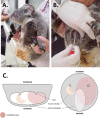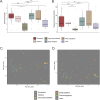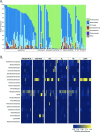Characterisation of the koala (Phascolarctos cinereus) pouch microbiota in a captive population reveals a dysbiotic compositional profile associated with neonatal mortality
- PMID: 37060097
- PMCID: PMC10105441
- DOI: 10.1186/s40168-023-01527-9
Characterisation of the koala (Phascolarctos cinereus) pouch microbiota in a captive population reveals a dysbiotic compositional profile associated with neonatal mortality
Abstract
Background: Captive koala breeding programmes are essential for long-term species management. However, breeding efficacy is frequently impacted by high neonatal mortality rates in otherwise healthy females. Loss of pouch young typically occurs during early lactation without prior complications during parturition and is often attributed to bacterial infection. While these infections are thought to originate from the maternal pouch, little is known about the microbial composition of koala pouches. As such, we characterised the koala pouch microbiome across the reproductive cycle and identified bacteria associated with mortality in a cohort of 39 captive animals housed at two facilities.
Results: Using 16S rRNA gene amplicon sequencing, we observed significant changes in pouch bacterial composition and diversity between reproductive time points, with the lowest diversity observed following parturition (Shannon entropy - 2.46). Of the 39 koalas initially sampled, 17 were successfully bred, after which seven animals lost pouch young (overall mortality rate - 41.18%). Compared to successful breeder pouches, which were largely dominated by Muribaculaceae (phylum - Bacteroidetes), unsuccessful breeder pouches exhibited persistent Enterobacteriaceae (phylum - Proteobacteria) dominance from early lactation until mortality occurred. We identified two species, Pluralibacter gergoviae and Klebsiella pneumoniae, which were associated with poor reproductive outcomes. In vitro antibiotic susceptibility testing identified resistance in both isolates to several antibiotics commonly used in koalas, with the former being multidrug resistant.
Conclusions: This study represents the first cultivation-independent characterisation of the koala pouch microbiota, and the first such investigation in marsupials associated with reproductive outcomes. Overall, our findings provide evidence that overgrowth of pathogenic organisms in the pouch during early development is associated with neonatal mortality in captive koalas. Our identification of previously unreported, multidrug resistant P. gergoviae strains linked to mortality also underscores the need for improved screening and monitoring procedures aimed at minimising neonatal mortality in future. Video Abstract.
Keywords: Dysbiosis; Endangered species; Enterobacteriaceae; Klebsiella pneumoniae; Koala; Marsupial; Muribaculaceae; Phascolarctos cinereus; Pluralibacter gergoviae; Pouch; Reproduction.
© 2023. The Author(s).
Conflict of interest statement
The authors declare no competing interests.
Figures








Similar articles
-
Individuality and stability of the koala (Phascolarctos cinereus) faecal microbiota through time.PeerJ. 2023 Jan 23;11:e14598. doi: 10.7717/peerj.14598. eCollection 2023. PeerJ. 2023. PMID: 36710873 Free PMC article.
-
Animal Age Affects the Gut Microbiota and Immune System in Captive Koalas (Phascolarctos cinereus).Microbiol Spectr. 2023 Feb 14;11(1):e0410122. doi: 10.1128/spectrum.04101-22. Epub 2023 Jan 5. Microbiol Spectr. 2023. PMID: 36602319 Free PMC article.
-
Successful artificial insemination in the koala (Phascolarctos cinereus) using extended and extended-chilled semen collected by electroejaculation.Biol Reprod. 2008 Apr;78(4):661-6. doi: 10.1095/biolreprod.107.064824. Epub 2007 Dec 19. Biol Reprod. 2008. PMID: 18094357
-
Using the Koala (Phascolarctos cinereus) as a Case Study to Illustrate the Development of Artificial Breeding Technology in Marsupials: an Update.Adv Exp Med Biol. 2019;1200:327-362. doi: 10.1007/978-3-030-23633-5_12. Adv Exp Med Biol. 2019. PMID: 31471803 Review.
-
Emerging arguments for reproductive technologies in wildlife and their implications for assisted reproduction and conservation of threatened marsupials.Theriogenology. 2023 Mar 1;198:19-29. doi: 10.1016/j.theriogenology.2022.12.008. Epub 2022 Dec 7. Theriogenology. 2023. PMID: 36529108 Review.
Cited by
-
Characterising the Tasmanian devil (Sarcophilus harrisii) pouch microbiome in lactating and non-lactating females.Sci Rep. 2024 Jul 2;14(1):15188. doi: 10.1038/s41598-024-66097-8. Sci Rep. 2024. PMID: 38956276 Free PMC article.
-
Group B Streptococcus vaginal colonisation throughout pregnancy is associated with decreased Lactobacillus crispatus and increased Lactobacillus iners abundance in the vaginal microbial community.Front Cell Infect Microbiol. 2024 Sep 30;14:1435745. doi: 10.3389/fcimb.2024.1435745. eCollection 2024. Front Cell Infect Microbiol. 2024. PMID: 39403199 Free PMC article.
-
Koala reproduction and the implications for human research.F S Rep. 2025 Apr 15;6(Suppl 1):13-18. doi: 10.1016/j.xfre.2024.12.006. eCollection 2025 Apr. F S Rep. 2025. PMID: 40487325 Free PMC article.
-
Unveiling microbial dynamics in terasi spontaneous fermentation: Insights into glutamate and GABA production.Curr Res Food Sci. 2024 Dec 9;10:100950. doi: 10.1016/j.crfs.2024.100950. eCollection 2025. Curr Res Food Sci. 2024. PMID: 39760015 Free PMC article.
-
Microbiota changes in lactation in the short-beaked echidna (Tachyglossus aculeatus).FEMS Microbiol Ecol. 2025 Apr 14;101(5):fiaf036. doi: 10.1093/femsec/fiaf036. FEMS Microbiol Ecol. 2025. PMID: 40194944 Free PMC article.
References
-
- Adams-Hosking C, McBride MF, Baxter G, Burgman M, de Villiers D, Kavanagh R, et al. Use of expert knowledge to elicit population trends for the koala (Phascolarctos cinereus) Biodivers Res. 2016;22:249–262.
-
- McAlpine C, Lunney D, Melzer A, Menkhorst P, Phillips S, Phalen D, et al. Conserving koalas: a review of the contrasting regional trends, outlooks and policy challenges. Biol Conserv. 2015;192:226–236. doi: 10.1016/j.biocon.2015.09.020. - DOI
-
- McCallum H, Kerlin DH, Ellis W, Carrick F. Assessing the significance of endemic disease in conservation—koalas, chlamydia, and koala retrovirus as a case study. Conserv Letters. 2018;11:e12425. doi: 10.1111/conl.12425. - DOI
Publication types
MeSH terms
Substances
LinkOut - more resources
Full Text Sources
Research Materials

